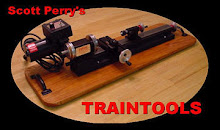HAZARD WARING! HOBBY KNIVES ARE VERY DANGEROUS IN THAT THEY ARE A SHARP CUTTING INSTRUMENT THAT CAN ACCIDENTALLY CAUSE LACERATIONS AND CUTS TO YOUR HAND AND OTHER BODY PARTS. EXTREME CAUTION SHOULD BE USED WHEN CUTTING AND SAFETY GLASSES SHOULD BE WORN. KEEP FINGERS AWAY FROM CUTTING AREA AND ALWAYS CUT AWAY FROM YOUR SKIN. ALWAYS USE A SHARP BLADE.
Knife Kit Assortment
All hobby stores and most general merchandise stores such as Walmart and Target carry these knives. There are many varieties and since you will be using this tool a lot, go ahead and invest in the best quality you can and get a number of them.
From left to right: standard knife, larger knife, fine blade, rotating blade, padded - non-rolling knife.
I personally like the padded knives as they are more comfortable when you are making repeated cuts. The hex nut top on the Excel brand knife keeps it from rolling of the table. I've had a knife roll off the table and stab me through my shoe.
Safety is a major concern with this popular tool. Few experienced modelers don't have a hobby knife scar. Mine is on my left hand and require three stitches as the blade slipped and cut me to the bone. Keep your blade sharp! Change them often. This will help prevent knife slips.
There is much debate on sharpening a new blade. You can use a whet stone, leather strop or diamond sharpener to get an even more sharp blade but I very seldom do this. More often than not I'll switch to a single edged razor blade for cutting that needs that level of sharpness.
We'd like to hear your thoughts on hobby knives! Post your comments below.




Scott, A comment on modeling knives:
ReplyDeleteThe best modeler's interchangeable blade knife I ever had was the first one my
parents got me when I was in about the fourth grade, back in the late '40s (that
was a golden age, no OSHA, even when it came to kids). The handle of that
X-Acto, which was made of something like bakelite, eventually broke, but the
mechanism was so good compared to even the ones that came immediately after it
that I kept the collet for old times sake.
More recently (much more recently) I came across that knife collet and, having a
Sherline lathe and mill, decide to make a new handle for it. When I did, I
discovered why that old collet worked so much better than the new ones: The
collet sleeve was steel! On the new ones, and by that I mean any X-Acto made
after 1950, the collet sleeve is made of aluminum. Aluminum collet and aluminum
sleeve. That spells galling. You can unscrew the collet head, but getting the
sleeve to release the knife blade from the collet requires whacking the butt end
of the collet on something hard over and over again. If you are unlucky enough
to have a knife handle with an unanodized threaded hole the problem is
compounded because you need a pair of pliers with teeth to unlock the screw.
The answer is simple -- for those with a lathe at their disposal. Make yourself
a new collet sleeve -- and the part with the threaded female hole if it is a
problem -- out of steel or brass. The knife will never lock up again.
Regards,
Tom Bank